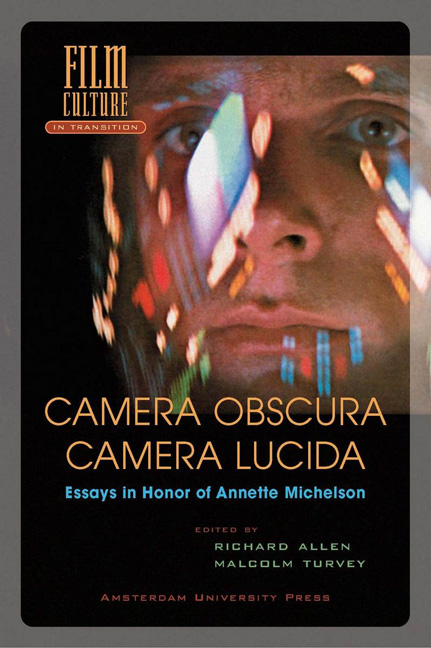Book contents
- Frontmatter
- Contents
- Acknowledgements
- Preface
- Introduction
- The Logic of an Illusion: Notes on the Genealogy of Intellectual Cinema
- Narcissistic Machines and Erotic Prostheses
- Loïe Fuller and the Art of Motion: Body, Light, Electricity and the Origins of Cinema
- Visitings of Awful Promise: The Cinema Seen from Etna
- Transfiguring the Urban Gray: László Moholy-Nagy’s Film Scenario ‘Dynamic of the Metropolis’
- Eisenstein’s Philosophy of Film
- Knight’s Moves
- Hitchcock and Narrative Suspense: Theory and Practice
- From the Air: A Genealogy of Antonioni’s Modernism
- Dr. Strangelove: or: the Apparatus of Nuclear Warfare
- Collection and Recollection: On Film Itineraries and Museum Walks
- Afterward: A Matter of Time: Analog Versus Digital, the Perennial Question of Shifting Technology and Its Implications for an Experimental Filmmaker’s Odyssey
- Select Bibliography
- List of Contributors
- Index
- Film Culture in Transition General Editor: Thomas Elsaesser
Afterward: A Matter of Time: Analog Versus Digital, the Perennial Question of Shifting Technology and Its Implications for an Experimental Filmmaker’s Odyssey
Published online by Cambridge University Press: 25 January 2021
- Frontmatter
- Contents
- Acknowledgements
- Preface
- Introduction
- The Logic of an Illusion: Notes on the Genealogy of Intellectual Cinema
- Narcissistic Machines and Erotic Prostheses
- Loïe Fuller and the Art of Motion: Body, Light, Electricity and the Origins of Cinema
- Visitings of Awful Promise: The Cinema Seen from Etna
- Transfiguring the Urban Gray: László Moholy-Nagy’s Film Scenario ‘Dynamic of the Metropolis’
- Eisenstein’s Philosophy of Film
- Knight’s Moves
- Hitchcock and Narrative Suspense: Theory and Practice
- From the Air: A Genealogy of Antonioni’s Modernism
- Dr. Strangelove: or: the Apparatus of Nuclear Warfare
- Collection and Recollection: On Film Itineraries and Museum Walks
- Afterward: A Matter of Time: Analog Versus Digital, the Perennial Question of Shifting Technology and Its Implications for an Experimental Filmmaker’s Odyssey
- Select Bibliography
- List of Contributors
- Index
- Film Culture in Transition General Editor: Thomas Elsaesser
Summary
In the South of France, some fifteen kilometers east of Avignon, in the summer 1970
It is a warm evening under a sky shining with stars on a terrace, with the smell of laurel trees overpowering lavender and thyme. The cicadas have stopped at sunset and in the quiet of the night the only noises now are the crickets and the croaks of some small green frogs in the irrigation ditches in the cantaloupe fields. I look at the sky but my mind is elsewhere, enchanted by what I am hearing about a film with an intriguing title about the distance of a wave. I am left puzzled by what I am told, a marvelous account of a complex time machine and philosophical toy. I am also curious to understand how one person can be so utterly fascinated by what somebody else has previously described to me as the most boring film ever made in which nothing happens, and it takes forty-five minutes to do so.1 How can something be an aesthetic revolution for one person and a negligible,inconsequential occurrence for another? That summer day I decided that I had to see it for myself, even if it meant traveling to New York City where the film was shot. (That would be my first airplane trip,my first of many other things as well.) I felt in love that night under the stars with the idea of understanding the complexity of the world and the seeming impossibility of satisfying the compulsion to solve contradictions. I also felt in love with the romantic urge to chart new territory.
Time has long passed since you could think there was a choice to be made between digital and analog, between pixel and silver-based. Of course you can still shoot in black and white film, but in the mind of almost everyone, film is now color, and it is digital. The image is now a bitmap made of pixels, and the grains of the silver image of the past can be added on with a simple aftereffect algorithm. Even when generated first by a film camera and not by a digital camera, and viewed principally in the form of a film print, the interaction of digital and film is everywhere inscribed in filmmaking processes today, in cinematography as well as editing and scoring.
- Type
- Chapter
- Information
- Camera Obscura, Camera LucidaEssays in Honor of Annette Michelson, pp. 261 - 274Publisher: Amsterdam University PressPrint publication year: 2003
- 1
- Cited by



